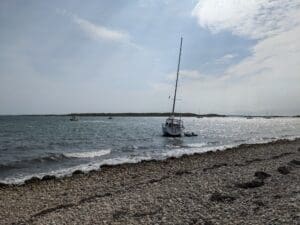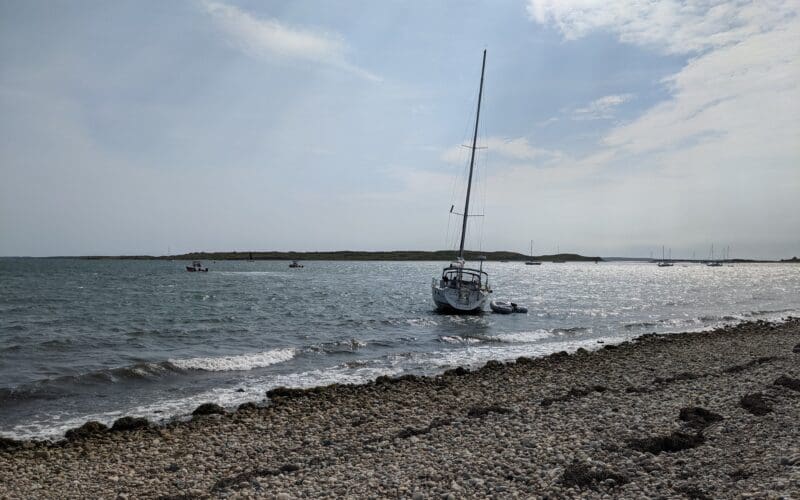By John Kettlewell

We all have a tendency to blame the hammer when we hit our thumb with it. It’s the same with anchors. You sail into a beautiful but crowded harbor, drop the hook while looking forward to celebrating with an evening cocktail, only to find the darn thing isn’t holding and instead of that Marguerita you have to pull on a mucky chain. Sometimes this process is repeated several times until something goes right and you have a solid bite, or you give up and look for a mooring.
Since I’ve been anchoring cruising boats for close to half a century I’ve had many moments of reflection around this problem. Perusing several online cruising forums recently, I am not alone in pondering why an anchor works sometimes and not others.
Yes, there are elements of luck at play. For example, we once dropped our hook into a deep hole in the middle of Annapolis Harbor and sat there like we were on a heavy mooring while boats dragged all around us in some severe squalls. On the other side of the coin, we once were dragging our anchor merrily through Newport harbor in a modest bit of wind. When we pulled it up the anchor was firmly wedged in a lobster trap that was not generating much holding power.
Then there are bottom types that are not conducive to a good night’s sleep, for example the jelly-like ooze found up creeks in the Chesapeake. No matter how much you back down on your anchor it just drags through the ooze. Or the runway-like bottom we encountered when anchored off of Tulum in Mexico. I spent an hour walking anchors around on the bottom trying to stick each point into any tiny indentation in the bottom. We spent a restless night hanging on three anchors and as much chain as I dared put out, and it was likely just the weight holding us in place.
But, more often than not I see abundant evidence that we are actually doing something wrong when the anchor doesn’t hold. I’m not talking about hurricane conditions. Most of the dragging I have observed has been during normal blows, like thunderstorms, frontal passages, or sometimes just a freshening breeze.
The first piece of evidence for our fallible nature has been observed on my own boat more than once. We drop the hook, it doesn’t hold, then we redrop more carefully and all is good through whatever winds come along.
The second piece of evidence is observing this exact same thing on many hundreds of boats on many more nights all around me. Two boats come in to anchor. They have the same anchor. One holds, the other doesn’t.
The third piece of evidence is observing how people drop their hooks, including on my own boat. When we first got our new Mantus anchor we eagerly dropped it in one of our favorite spots where I know the bottom like I do my own. We proceeded to drag that thing all over the place as we backed down. My first thought was, “So much for these so-called “New-Gen” anchors!” But, it was my mistake! After pulling the anchor up it was obviously fouled with our own chain wrapped around one of the ears supporting the hoop. We had dumped a bunch of chain way too fast and right on top of the anchor because I had left the windlass brake too loose.
Other times when we have dragged our initial anchor set I have rechecked my math and realized that I didn’t have enough chain out. This is easy to do in a crowded harbor where you are trying to fit in between other boats already at anchor. Another bad move is to try and anchor in a known weedy area, only to fail to hold while cursing the anchor that comes up with a giant ball of grass.
My final piece of evidence for this problem is published in many books about cruising and in decades of experience when we anchored everywhere from Labrador to the Caribbean without the benefit of New-Gen anchors, all-chain rode, windlasses, or scientific anchor testing. We used steel Danforths, CQRs, Bruces, and the occasional fisherman pattern anchor, and we did it successfully. So most often it’s not the anchor but the technique of the user that’s causing the problem.
Using these new wonderful tools has spoiled us to the point we expect them to just work no matter what we do. Dump them over the side on all-chain rodes, then break out the cocktails! Unfortunately, it is not that simple. Before blaming your tools make sure you are using them properly!
John Kettlewell recently retired as the executive director of Sail Martha’s Vineyard. He’s cruised the waters between Labrador and South America for more than 45 years.

